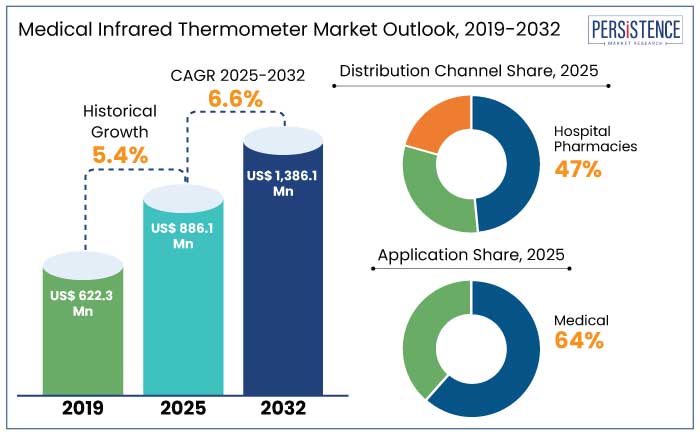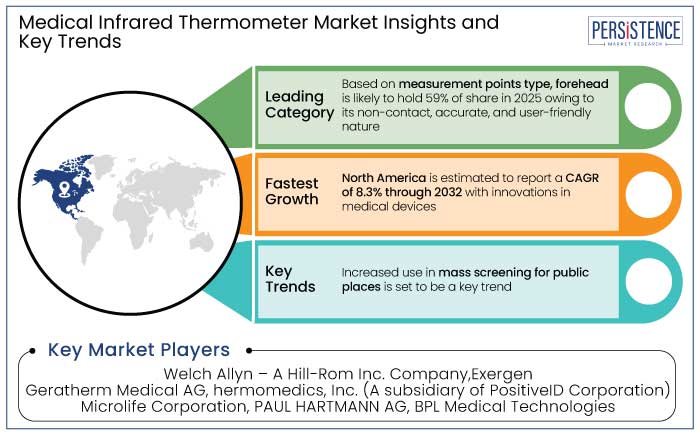Industry: Healthcare
Published Date: January-2025
Format: PPT*, PDF, EXCEL
Delivery Timelines: Contact Sales
Number of Pages: 194
Report ID: PMRREP35102
The global medical infrared thermometer market is estimated to reach a size of US$ 886.1 Mn in 2025. It is predicted to rise at a CAGR of 6.6% through the assessment period to attain a value of US$ 1,386.1 Mn by 2032.
Surging need for non-contact temperature measurement in industries like healthcare, automotive, and food safety is driving demand for infrared thermometers. Improvements in technology like IoT and AI integration, which improve accuracy and allow real-time data collecting, are also spurring demand for medical thermometers.
In September 2024, Google announced the rollout of its Pixel Thermometer feature to 24 countries in Europe, such as the U.K. Using infrared sensors to assess body temperature, Pixel 8 Pro devices are integrating intelligent capabilities into their health monitoring tools.
Manufacturers are prioritizing accuracy to extend into diverse markets such as medical, industrial, food and beverage, and pharmaceutical sectors. Professionals and consumers alike use infrared thermometers because of their affordability, linearity, and dependability.

Key Highlights of the Markets
|
Market Attributes |
Key Insights |
|
Medical Infrared Thermometer Market Size (2025E) |
US$ 886.1 Mn |
|
Projected Market Value (2032F) |
US$ 1,386.1 Mn |
|
Global Market Growth Rate (CAGR 2025 to 2032) |
6.6% |
|
Historical Market Growth Rate (CAGR 2019 to 2023) |
5.4% |
North America, including the U.S., Canada, and Mexico, is set to account for 33% of the global medical infrared thermometer market share in 2025, despite its mature status. Infrared thermometers are widely used in manufacturing and construction due to their non-contact temperature measurement, which is crucial for safety and efficiency. Demand for smart thermometers in North America is estimated to record a CAGR of 8.3% from 2025 to 2032. For example,
In 2025, Asia Pacific is projected to dominate the medical infrared thermometer market, driven by technological developments and widespread adoption. The region's market is likely to generate a share of 29% in 2025 and is set to record a CAGR of 8.4% from 2025 to 2030.
India is set to record the highest CAGR of 7.8% in Asia Pacific due to rising healthcare infrastructure and increasing research and development expenditures. Leading companies such as Omron Healthcare and Braun have been instrumental in introducing unique infrared thermometers tailored to the needs of Asia Pacific. For example,
In 2025, forehead-type infrared thermometers are set to dominate the global market, accounting for 59% share. This is owing to their rapid and reliable body temperature readings, which are critical for identifying diseases. The low handling costs and non-invasive nature of these devices make these a valuable tool for healthcare professionals. Leading manufacturers have contributed to this trend by introducing innovative products. For instance,
Such developments reflect the ongoing efforts by companies to meet the rising demand for efficient and reliable temperature measurement solutions in healthcare settings.
In 2025, the medical application segment is anticipated to hold a dominant global share of 64%, driven by focus on infection control measures and rising prevalence of infectious diseases. For ins
The COVID-19 pandemic highlighted the need for non-contact temperature assessment tools in medical facilities. Manufacturers are estimated to develop novel products for accurate scanning. For example,
The industry's dedication to meeting the urgent demand for precise diagnostics and efficient infection control in healthcare settings is reflected in such developments.
The need for contactless temperature checking and rising awareness of infection prevention has led to a spike in the usage of infrared thermometers in healthcare. The need for home healthcare solutions has grown due to developments in Bluetooth and IoT technologies, such as Braun's ThermoScan. For example,
The need for dependable home temperature monitoring devices is rising due to telemedicine services and veterinary clinics. These are illustrating the revolutionary effect of technological developments on the infrared thermometer industry and opening new business prospects.

The global medical infrared thermometer market recorded a CAGR of 5.4% in the historical period from 2019 to 2023. In the period of the global pandemic, leading players stayed afloat by launching various products in the healthcare industry.
A non-contact infrared thermometer was introduced by wellness and health products business Neptune in May 2020 in an effort to boost availability in North America during coronavirus outbreaks. With FDA approval, the healthcare business Cole-Parmer produced a noncontact thermometer in June 2020 that can record 32 internal readings and take temperatures from a variety of surfaces and objects.
Thermo Check, a completely automated contactless infrared thermometer from iGear, was introduced in July 2021. It can be mounted on walls or tripods at gates to measure visitors' body temperatures on its own. Demand for medical infrared thermometers is estimated to record a considerable CAGR of 6.6% during the forecast period between 2025 and 2032.
Evolution of Pediatric Healthcare to Boost Utilization of Touchless Thermometers
The need for non-invasive temperature measuring devices, especially infrared thermometers, has surged dramatically due to the restructuring of the pediatric healthcare industry. For instance,
Infrared thermometer devices are becoming increasingly popular, according to recent data from leading children's hospitals. Manufacturers have responded to this change by creating child-friendly equipment. One example is Philips' PlayTemp line, which uses entertaining game components to encourage kids to participate in regular temperature checks. For instance,
Surging Developments in Sensor Technology to Augment Demand
Innovations in sensor technology have made medical-grade precision possible by improving accuracy and calibration. Multipurpose gadgets help improve health monitoring by combining vital sign measures with infrared thermometry. By improving the integration of vital signs and improving health monitoring, artificial intelligence in temperature evaluation creates new commercial prospects. For example,
Healthcare providers have expressed a great deal of interest in this predictive potential and are keen to integrate these developments into clinical settings as well as home healthcare options.
Lack of Accurate Crowd Scanning Feature May Impact Product Penetration
It might be difficult to scan a large patient pool in public places with the help of infrared thermometers. Consumer-grade infrared thermometers differ significantly from clinical standards in terms of accuracy, according to a research published in the Journal of Medical Devices.
New recommendations from the FDA resulted in a 25% increase in production costs. Small-scale firms are finding it difficult to fulfill the new criteria, which has resulted in market concentration.
Sales of consumer-grade devices have decreased by 30% as the post-pandemic sector became saturated. Price pressure resulted from key merchants reporting surplus inventories. To preserve profit margins, manufacturers are increasingly concentrating on high-end features and medical-grade equipment.
Regulations on Public Health Checkup to Provide Detailed Oversight
Healthcare product makers are set to benefit from government measures that promote public health infrastructure growth. Strong institutional demand is maintained by ongoing requirements for public health surveillance. For example,
Public buildings and leading transit hubs made investments in cutting-edge infrared scanning technology. For instance,
Use of Infrared Thermometers in Hospitals to Help Resolve Multiple Issues
The ability of infrared thermometers to precisely measure heat radiation from the forehead and ears makes these an essential tool for identifying COVID-19 symptoms. It is set to boost demand for these devices in the healthcare sector. Its affordability, mobility, and non-contact quick screening capabilities are propelling demand from hospital pharmacies. For example,
Since accurate measurement prevents internal components from being damaged and yields the required results, the market is anticipated to surge as infrared thermometers are increasingly being used in other sectors to monitor surface temperature in medical institutes.
Prominent pharmaceutical companies, especially in the field of medical infrared thermometers, are extending their product lines and looking into expansion prospects in emerging nations. To raise their market share, they are creating cutting-edge technology and purchasing new products. Large-scale companies are introducing new medications and actively seeking strategic mergers and acquisitions.
Leading manufacturers are also concentrating on technical developments, producing cutting-edge goods that extend the range of items available worldwide. In addition to improving patient treatment options, this innovation boosts competitiveness, enabling companies to adapt to changing patient and healthcare provider demands.
Recent Industry Developments
|
Attributes |
Details |
|
Forecast Period |
2025 to 2032 |
|
Historical Data Available for |
2019 to 2023 |
|
Market Analysis |
US$ Billion for Value |
|
Key Regions Covered |
|
|
Key Market Segments Covered |
|
|
Key Companies Profiled in the Report |
|
|
Report Coverage |
|
|
Customization and Pricing |
Available upon request |
By Measurement Points Type
By Application
By Distribution Channel
By Region
To know more about delivery timeline for this report Contact Sales

The market size is set to reach US$ 1,386.1 Mn by 2032.
Hospitals are set to use Tympanic, Axilla, Rectal, and Non-contact infrared thermometers.
In 2025, North America is set to attain a market share of 33%.
In 2025, the market is estimated to be valued at US$ 886.1 Mn.
Welch Allyn – A Hill-Rom Inc. Company, Exergen, Geratherm Medical AG, and Thermomedics, Inc. are a few key players.